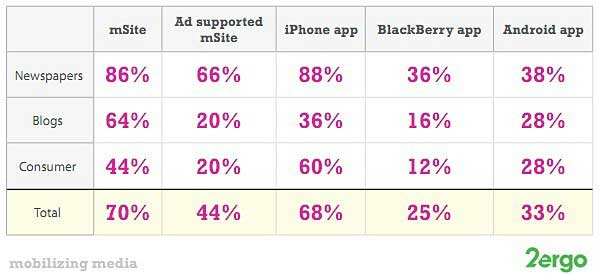Led by large news organizations, the media industry is responding to the enormous market demand for mobile access: 84% of the top US media publications have developed a mobile website, a mobile app, or both, according to a study by 2ergo.
Among the top 100 US media outlets (including the top 50 news sites, 25 blogs, and 25 consumer magazine sties, according to the BurrellesLuce's 2011 Media Outlet Ranking):
- 70% have a mobile website and 44% have an ad-supported mobile site.
- iPhone apps are the most popular: 68% have developed apps for iPhones; 33% for Android devices; and 25% for BlackBerry devices.

On average, the top 25 national newspapers, such as The Wall Street Journal, USA Today, The New York Times, and The Los Angeles Times, lead the way in providing mobile-friendly experiences:
- 86% have a mobile site and 66% have monetized their sites via mobile ads.
- 92% of them having released at least one app and 28% have all three types of applications.
- 88% have an iPhone app, 38% have an Android app and 36% have a BlackBerry app.
The top 25 consumer magazines (e.g, National Geographic, Better Homes and Gardens, Time, and AARP Magazine) have been slower to respond to the needs of the mobile reader:
- 44% have a mobile site and 20% supplement their revenues with mobile advertising.
- 64% have released at least one mobile app.
- 60% have an iPhone app, 28% have an Android app, and only 12% have a BlackBerry app.
Most of the top 25 blogs (e.g., The Huffington Post, TechCrunch, and Mashable) have developed mobile-optimized websites, but on average, they lag behind magazines in engaging consumers via mobile apps:
- 64% have a mobile site and only 20% are supported by third-party advertising.
- Only 36% have at least one platform-specific mobile app.
Digital content can be delivered to mobile devices via mobile sites (websites optimized for the mobile screen) and native applications.
Consumers are likely to be more loyal to brands once they have an app on their phone, but mobile sites allow publishers to reach a wider and growing audience (because smartphones can access mobile sites via Web browsers and mobile search, attracting organic traffic).
Mobile search queries already account for roughly 15% of all Google search volume across categories, according to Google. Not surprisingly, the nation's largest (and resource-rich) media outlets are taking action.
About the data: Findings are based on a review of mobile websites and smartphone applications among BurrellesLuce's 2011 Top Media Outlets (top 50 newspapers, 25 blogs, and 25 consumer magazines) in the US issued in February 2011. 2ergo conducted the review in March 2011.



